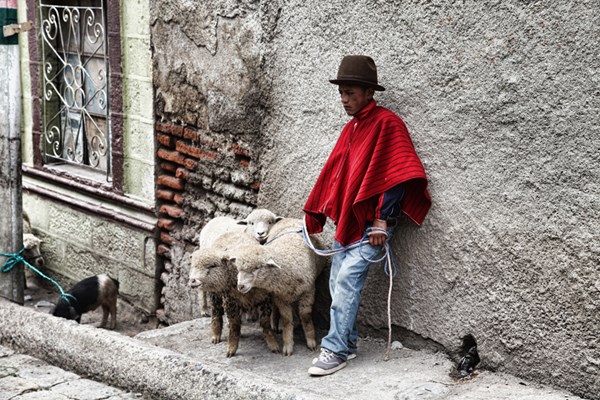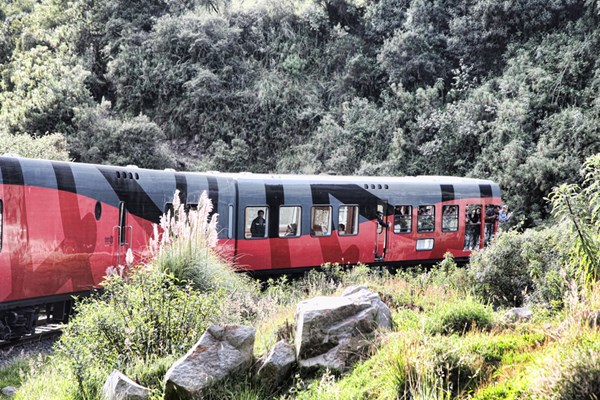QUITO, Ecuador, Aug. 14, 2013 (GLOBE NEWSWIRE) -- Posicionarte, a travel media agency, was invited to discover the brand new Ecuador's cruise train trip 4 days 3 nights from the Andes to Coast, it´s travel editor Andrew Taylor takes us on a train ride through the Ecuadorian Andes, a journey of spiritual and cultural fascination.
Imagine being born in the barren highlands of the Ecuadorian Andes, a land that is relatively unchanged for a thousand years. You may have a small horse and wear llama chaps and a baseball cap. You go to a market where you barter crops for livestock, poultry for car parts or eggs for a tincture (or a healing.)
You live in a province (that you have never left) that'ss named after your volcano (that you see every day) that is also the God of your descendants. Your Grandfather might have been a hielero, who twice a week took a donkey to climb the volcano to bring back glacial ice to sell in the market.
You live a modest life. You may or may not have electricity, if you do you might have a television, but I couldn´t vouch for the quality of the signal. You are likely to marry someone who lives within a 25 kilometre radius of your family home and you will undoubtedly have quite a few guaguas (children.)
Then one day, whilst tending a field, you hear in the distance the tolls and tinkers of hammers on iron. The railway track is being restored and you will wonder what it will bring. There will be rumours and myths, objections and excitement.
Finally, that glorious day arrives, with the trumpeting wail and the trundle of the shiny red wagons across the landscape. Instinctively you wave at the people inside, knowing that they will be passing momentarily and then disappear, like an apparition. Now picture yourself on the train. You trundle past rivers and houses, country schools, fields and pastures. Women hold up their children, young men give a solitary nod and dogs bark and chase you until they give up. This is the thrill of the ride, sharing waves with people so different, and yet so similar – for an instant.
The best place is the shaded viewing terrace at the back and the climax of this excitement is when the train goes right down a huge wide main street and you're being filmed on everyone´s mobiles, and there´ security scooters patrolling each side of the tracks.
The National Parks of Cotopaxi Volcano and Chimborazo Volcano natural reserve are vast highland reservations plotted and defined by volcanoes. The Andinos or Serranos, as the coastal people name them, describe their weather patterns as containing all four seasons in a day, often with intense sunshine in the morning and bouts of heavy rain in the afternoon. The nights are fresh but cold. The mountain dwellers are almost all descendants of the Quichua de la Sierra people. This Avenue of Volcanoes was once an Incan trail. Until colonial Christian beliefs were stamped over the society, each mountain was a divinity. The Avenue of Volcanoes segment of the trip will show no less than 14 volcanoes between active and dormant over 4000 meters each, Alexander von Humboldt, a german scientist, named it based on that fact in the XVII century.
The scenic train journey in Ecuador takes you from the highland city of Quito to coastal Guayaquil. Each has its own International Airport. This four day guided tour, gives you tastes of three distinct areas of spiritual and cultural significance: colonialism, el campo (the countryside), and communities.
Colonialism
You visit three very different haciendas, a rose plantation and a cacao plantation. The first hacienda (San Agustín de Callo) is set at the altar of the phenomena that gives its name to the Cotopaxi volcano. Coto-paxi comes from the kichwa name for neck and the Mayan name for moon (the neck of the moon.) Every 25 years on New Year´s Eve, from this point, la luna appears to sit snugly on the volcano´s crater, a synergy that was considered divine. San Agustín de Callo is built around an Incan chapel and boasts large comfortable rooms with wood fires and the odd Jacuzzi.
La Cienega hacienda, where you spend your first night, is designed in monastic style with cloisters around an inner contemplation garden with a trickily central fountain. It too has a beautiful chapel and you may notice the staff (mostly direct descendants of the original servants) taking two minutes out to genuflect and pray there. There´s rumours of a ghost in room 9.
El Campo
The variety of countryside is spectacular. The train line threads through very remote highlands, the highest station being El Boliche at 3547 metres above sea level. As you pass through one ecosystem to another the land changes subtly from ploughed fields of potatoes, corn and alfalfa to the nevadas of wild paja viraba, a highland grass that was once relied upon as a popular building material. We stand at the base of Chimborazo mountain, on a flat paramo that looks utterly barren until you look down at your feet, and notice the tiny little plants with their bright flowers, designed small to survive the bright sun and the cold nights.
As you go deeper into the voyage, the people in the fields waving...have a dress change, most are now wearing traditional costumes with their distinct shawls and ponchos. Our descent into the cloud forest and coastal plains makes us very grateful for the air conditioning and made sense of why this train line was the Pride of the Nation. It linked coast and highland. Before refrigeration, ice was chipped off the glacier and taken to the beach to keep fish fresh and bananas and oranges were shipped up to the mountain dwellers.
Community
The fourth day's excursion is a visit to a Shuar Community. The Shuar way of life is very different to our modern ways. They live with a very immediate infinity with their surroundings (largely cloud forest) and connect with plants, rivers and other animals as fellow spirits, only taking what they need to survive and always doing so with a ritual of thanksgiving.
After the Jesuit Missionaries settled with the Shuar in the 1940s, practices like head shrinking and polygamy were discouraged whereas other beliefs and rituals remain. The Shuar People were very welcoming and showed us fragments of their extra-ordinary culture with a a ritual of casting out evil spirits, a snack served on a table of banana leaves, a warrior dance, and a healing ceremony by an Uwishin, (a female shaman.) At around 14 years old Shuar boys spend a month alone in the jungle and traditionally drank hallucinogenic medicine. Spirits would appear to them and if they had the courage to reach out and touch one, they entered a higher level of awareness. Talk about facing your demons!
The Tren Crucero Excursion is a confidently engineered experience. The onboard team are really personable, educated and experienced,(each with their own special knowledge depending on their ancestry and personal interests.) The service is first class, and the trip is a thrill. Until New Years Eve 2013 the trip is $990 all inc. It's worth sniffing around Ecuador´s scenic train journey website
Photos accompanying this release are available at:
http://www.globenewswire.com/newsroom/prs/?pkgid=20493
http://www.globenewswire.com/newsroom/prs/?pkgid=20494
CONTACT:Jorge Alvarado
jalvarado@posicionarte.net
59-3-222-48134
www.posicionarte.net

